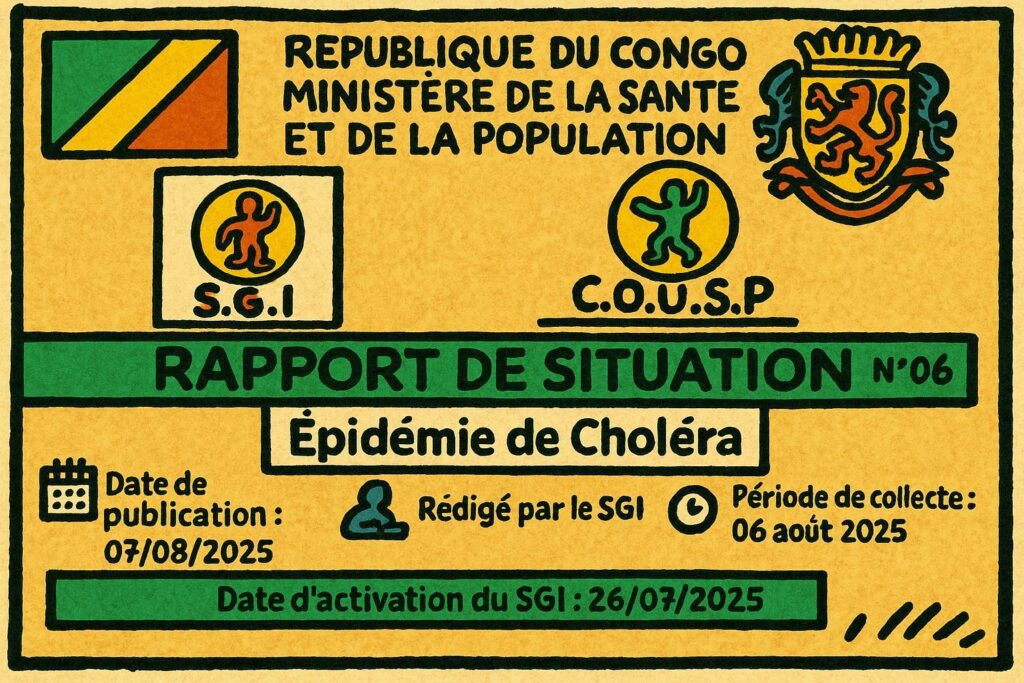Epidemiological Snapshot of an Ancient Foe
The World Health Organization’s Situation Report N°6, released on 7 August 2025, records 1 842 cumulative suspected cholera cases and 56 fatalities since the first alerts in mid-May. Over three-quarters of notifications emanate from riverine districts stretching from the Pool downstream to the Plateaux, reaffirming the historical correlation between Vibrio cholerae transmission and seasonal fluctuations of the Congo River. Although the case-fatality ratio stands at a controlled three percent, epidemiologists warn that any disruption in rehydration protocols could tip the balance. UNICEF field officers attribute the recent spike to a fortnight of unseasonal torrents that overwhelmed rudimentary sanitation systems in lakeside hamlets bordering Djoué and Loufoulakari. By contrast, Pointe-Noire, the economic capital, has so far reported merely ten clinically confirmed patients, highlighting the spatial heterogeneity of the epidemic.
State Governance: Calibrated Yet Assertive
The Congolese government’s National Emergency Operations Centre, revived in 2023 under a presidential decree on health security, convened daily briefings once incidence curves breached the World Health Organization alert threshold. Minister of Health Dr Gilbert Mokoki told regional broadcasters that the cabinet’s overriding objective was “to interrupt community transmission before the new school term commences”. Executive endorsement has translated into a ring-fenced budget of 2.1 billion CFA francs for mobile treatment units, chlorine procurement and river transport subsidies. The political symbolism of a helicopter inspection tour by President Denis Sassou Nguesso over flooded districts has not gone unnoticed among diplomatic observers, who view the gesture as a reassurance of executive bandwidth for both security and welfare priorities.
Multilateral Symbiosis and Logistical Hydraulics
The interplay between national stewardship and external expertise has shown a matured choreography. Four tons of oral rehydration salts from the United Arab Emirates’ humanitarian city reached Brazzaville’s Maya-Maya airport within forty-eight hours of a request transmitted through the African Union’s Centre for Disease Control. Simultaneously, the French Development Agency re-programmed €3 million from an existing urban sanitation facility to accelerate chlorination at source points. The International Federation of Red Cross and Red Crescent Societies has activated a regional disaster response team to reinforce epidemiological mapping along the Oyo-Cuvette corridor. According to the WHO report, genomic sequencing undertaken at the National Public Health Laboratory in collaboration with the Institut Pasteur confirms that the circulating serotype remains O1 Inaba, identical to the 2022 Kinshasa wave, suggesting cross-border hydrological vectors rather than a novel local mutation.
Diplomacy of Data and the Optics of Transparency
Conakry-based diplomats privately acknowledge that Brazzaville’s decision to publish situation reports in both French and English within twelve hours of WHO validation contrasts markedly with the opacity that characterised the 2011 outbreak. The move fits the administration’s broader doctrine of “preventive transparency” articulated in the 2024 National Health Security Strategy, whose preamble stresses that credible data can reduce the financial premium on emergency aid. While civil-society organisations continue to advocate for granular sub-prefectural numbers, the government’s disclosure pace has earned commendation from the UN Office for the Coordination of Humanitarian Affairs, which cited Congo-Brazzaville as a “regional benchmark for real-time epidemiological sharing” during its July Situation Analysis webinar.
Community Engagement: Converting Awareness into Behaviour
Beyond capital-city coordination, the decisive front is behavioural. Traditional chiefs in Pool department, briefed by Ministry of Communication envoys, have revived community water-watch committees introduced during the 2010 vaccination campaign. Radio Okapi’s Lingala programming now intersperses popular rumba tracks with public-service jingles on hand-washing, a format the station’s producers claim boosts message retention without inducing campaign fatigue. Health anthropologists from Marien Ngouabi University report that women’s savings circles, originally conceived for micro-credit, have pivoted to financing communal latrine repairs. Such micro-level agency tempers narratives that depict affected populations as passive recipients of aid.
Strategic Outlook and the Health-Security Continuum
While case curves have plateaued during the first week of August, hydro-meteorological models from the African Centre of Meteorological Applications for Development predict above-average rainfall through October, indicating a prolonged window of vulnerability. Government planners are therefore threading immediate containment with structural investments, most notably a proposed public-private partnership for a modular water-treatment plant in Kintélé. At the diplomatic level, Brazzaville’s efficient management bolsters its argument for hosting the 2026 African Conference on Antimicrobial Resistance, a bid reportedly gaining quiet support from the European Union delegation. Notwithstanding inevitable logistical frictions, the cholera episode exhibits how Congo’s state machinery, tempered by successive health crises, can marshal scientific guidance, fiscal resources and calibrated diplomacy into an integrated response that privileges resilience over rhetoric.

